Photos: Astrophotographers capture stunning views of the night sky for 2021 contest

The heavens look gorgeous through the lenses of expert astrophotographers. Nebulas, galaxies, the moon and sun, and even the stars take on an artistic glow when captured with the right eye, equipment and light. Here's a look at stunning astronomy images from the Royal Observatory Greenwich's Astronomy Photographer of the Year competition. (Read more about the competition and its winners.)
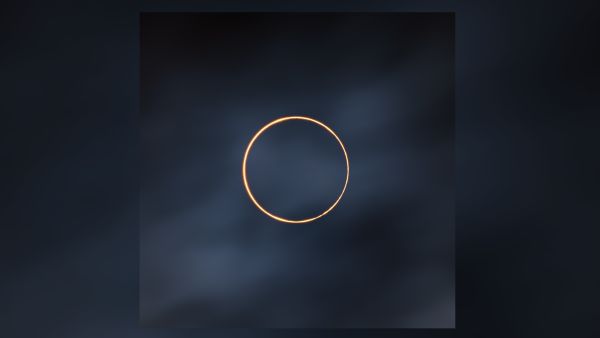
The Golden Ring
The overall winner of the 13th annual Astronomy Photographer of the Year award is photographer Shuchang Dong of China, who took this unearthly shot of an annular solar eclipse from the Ali region of Tibet on June 21, 2020. The image also won in the "Our Sun" category of the competition.
The photograph is "moody, serene, perfectly captured and expertly processed. You feel as if you could reach into the sky and place this onto your finger," said contest judge Steve Marsh.
Equipment used: Fujifilm XT-4 camera; Sun: 386 mm f/10 lens, ISO 160, 1/2000-second exposure; Moving cloud: ND1000 filter, 386 mm f/16 lens, ISO 160, 1-second exposure
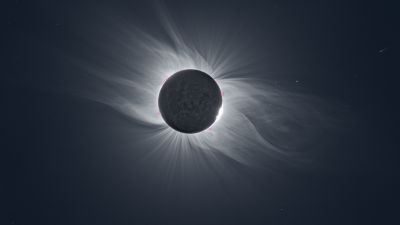
The Sun sharing its Crown with a Comet
Runner-up in the "Our Sun" category goes to a stunning image of an eclipse, which shows the tendrils of the sun's upper atmosphere (corona) as well as bright spots seen during eclipses called Bailey's Beads. Most surprising is comet C/2020 X3 (SOHO), swooping in from the far right side of the image. French photographer Vincent Bouchama caught this shot from Argentina.
Equipment used: William Optics ZenithStar 61II APO telescope, Williams Optics Flat 61 lens at f/5.9, Vixen GPD SkySensor 2000PC mount, Canon EOS 760D camera; Sky, sun and comet: ISO 200–800, 1/800–0.6-second exposures; Moon: ISO 200–800, 0.6-second exposures; Prominences and Baily's beads: ISO 200, 1/4000-second exposures
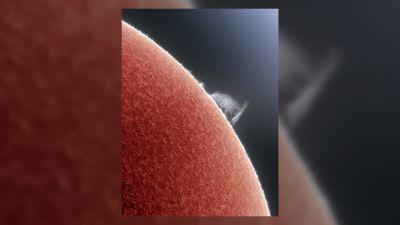
Curtain of Hydrogen
A prominence of hydrogen dances off the sun in this image captured by American Alan Friedman from Buffalo, New York. This image took home a "highly commended" in the "Our Sun" category.
"This beautiful large prominence graced the limb of the Sun over several days and was recorded in good seeing conditions," Alan said in a statement. "Good seeing conditions here refer to the steadiness of the Earth's atmosphere rather than to cloudless skies. Only when the atmospheric turbulence is low can fine details and structures be seen with clarity."
Equipment used: Astro-Physics 92 mm f/4.8 Stowaway refractor telescope working at 1.7 m focal length with Baader FFC, 90 mm Coronado Solarmax Ha filter, Astro-Physics 1200 mount, Grasshopper 2MP monochrome streaming camera, 1/1000-second exposure
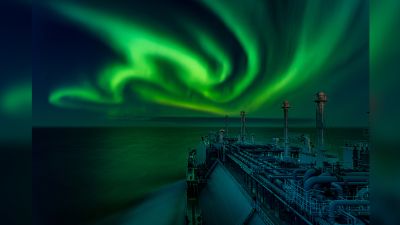
Polar Lights Dance
The Northern Lights dance over the approach to the Kara Strait in Russia in this image taken in a 25-second exposure by Russian photographer Dmitrii Rybalka that won the Astronomy Photographer of the Year "Aurorae" category.
"I was keeping watch at night as Third Officer on the bridge of the ship, when I noticed in the sky a tiny white band approaching like a snake," Rybalka said in a statement. "I knew already, this is it, this is that I was waiting for. I took my camera, went to the bridge wing, took my position and started waiting, like a hunter waiting for its prey. A few minutes later, the sky was full of bright green lights dancing in darkness and shining over everything on their way."
Equipment used: Sony ILCE-7M3 camera, 28 mm f/2.8 lens, ISO 100, 25-second exposure
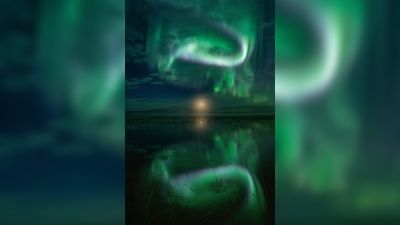
Proper Welcome for the Moon
Finnish photographer Thomas Kast caught the aurora in conjunction with the moonrise in Lapland. This image was the runner-up in the "Aurorae" category of the Astronomy Photographer of the Year competition.
"It was a quiet, calm night at this lake watching the moonrise when suddenly the aurora became very strong and started to dance quickly," Kast said. "Further out on the lake there was fog which gave the Moon a nice circle as well. The reflections were magical!"
Equipment used: Nikon D850 camera, 15 mm f/2.8 lens, ISO 400, 1.6-second exposure
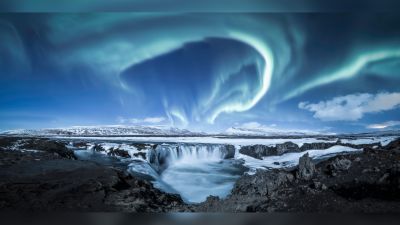
Goðafoss Flow
The semifrozen Goðafoss waterfall in northern Iceland provides an icy counterpoint to the Northern Lights in this image, which took home a "highly commended" in the "Aurorae" category of this year's photography competition. Photographer Larryn Rae captured this image on a 14-degree Fahrenheit (minus 10 degrees Celsius) night when the full moon and the aurora flooded the landscape with light.
Equipment used: Canon EOS 5D Mark IV camera, 24 mm f/2.5 lens, ISO 2500, 16 x 2.5-second exposures
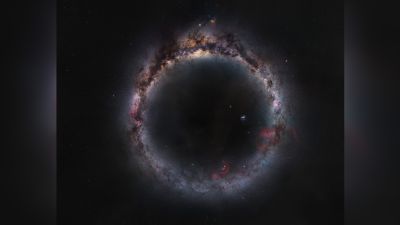
The Milky Ring
Taking the prize in the competition's "Galaxies" category is Chinese photographer Zhong Wu's "The Milky Ring." This image is a 360-degree image of the Milky Way stitched together with photos taken in China and New Zealand.
Equipment used: Nikon D810a camera, 40 mm f/1.4 lens, ISO 8000, 1000 x 6-second exposures
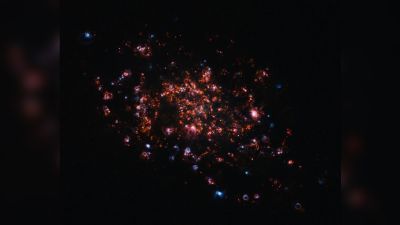
The Nebulae of the Triangulum Galaxy
American Russell Croman took runner-up in the "Galaxies" competition with this sparkly spot of the heart of the Triangulum Galaxy, which he took from New Mexico.
"In ideal circumstances, it is just possible to see this galaxy with the naked eye despite being more than two and a half million light years away." Russell said in a statement. "Most magnified images concentrate on the vibrancy and clarity of the billions of stars within. Here, we have something rather different, highlighting the delicate nebulosity of the galaxy. The planets forming around the new stars within those stellar nurseries may one day teem with life of their own."
Equipment used: Takahashi FSQ106 EDX4 530 mm telescope at f/5 and PlaneWave 14" CDK 2543 mm telescope at f/7.2, Chroma filters, Software Bisque Paramount MX+ and Paramount ME-II mounts, RB-SII-Ha-OIII composite, 49.5 hours total exposure
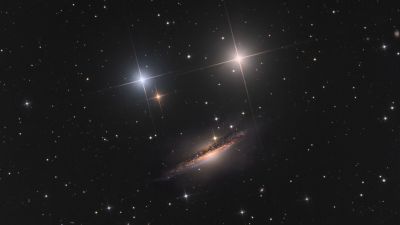
A Smiley in Space
Recognized as "highly commended" by the Astronomy Photographer of the Year judges, this image seems to smile back at the viewer. An edge-on view of the galaxy NGC 1055 forms a wry smile, while stars in the Milky Way in the foreground seem to twinkle like eyes. The photographers are from France and Australia and captured this image from Chile.
Equipment used: Planewave CDK 17" telescope at f/6.8, Astrodon filters, Software Bisque Paramount ME mount, SBIG STXL-11002 camera, L-RGB-Ha composite, 27.5 hours total exposure
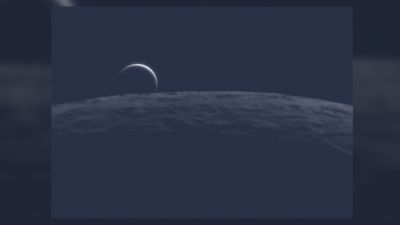
Beyond the Limb
This shot that seems to come from an alien galaxy is the winner of the Astronomy Photographer of the Year 13 "Our Moon" category. As the competition name suggests, it is in fact the surface of Earth's moon, with the crescent of Venus rising above its horizon. French photographer Nicolas Lefaudeux captured this image in daylight.
Equipment used: Celestron C11 2800 mm telescope at f/10, iOptron iEQ30 mount, Basler ACA2500-14GC camera. Occultation: 1 x 2.5-millisecond exposures. Venus: 50 x 2.5-millisecond exposures. Moon: 200 x 15-millisecond exposures
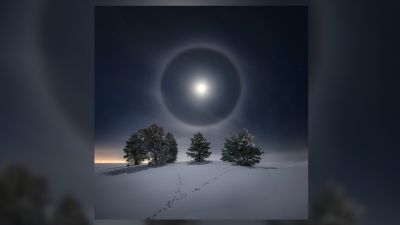
Lunar Halo
Taking the runner-up spot in the "Our Moon" category is Swedish photographer Goran Strand. Strand's image shows the light of the moon reflecting in suspended ice crystals above a snowy landscape in Östersund, Sweden. The tracks belong to a local rabbit.
Equipment used: Nikon Z6 II camera, 14 mm f/5.6 lens, ISO 200, 6 x 15-second exposures
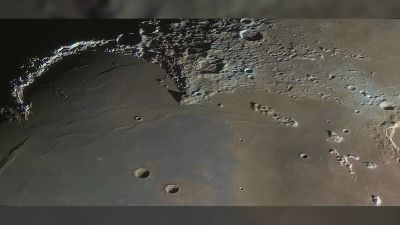
Iridium to Imbrium
The lunar landscape gets its due in this "highly commended" image in the "Our Moon" category. Australian photographer Stefan Buda increased the color saturation on this image to highlight the desolation of the moon's surface.
Equipment used: Self-built Dall-Kirkham 405 mm telescope at f/16, self-built Alt-Azimuth fork mount, Astrodon RGB filters, ZWO ASI120MM camera, 9,000 x 0.0625-second exposures
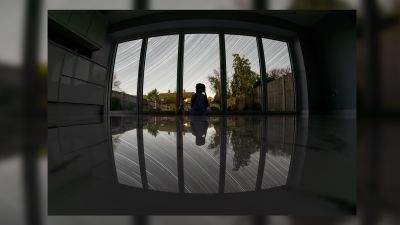
Lockdown
The pandemic lockdown of early 2020 led to this image captured in Windsor in the United Kingdom. This image took home the winning prize in the "People and Space" category of this year's Astronomy Photographer of the Year competition.
Equipment used: Sony ILCE-6600 camera, 8 mm f/4 lens; Foreground: ISO 1600, 8-second exposure; Sky: ISO 1000, 844 x 30-second exposures
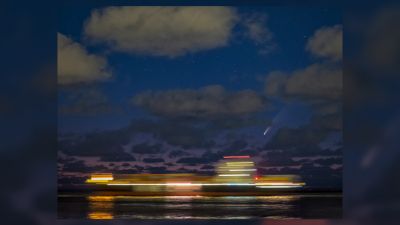
A Lonely Ship Under the Stars
The comet NEOWISE streaks across the sky above a ship passing through the Nieuwe Waterweg canal near Rotterdam. Photographer André van der Hoeven captured the blurred lights of the moving ship and the comet's long tail superimposed against a purple-blue sunset. The image won runner-up in the "People and Space" category.
Equipment used: Tamron 24–70 mm telescope at f/2.8, Nikon D810a camera, ISO 800, 5-second exposure
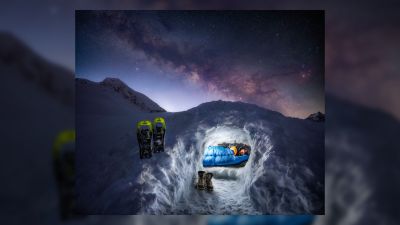
Break of a New Day
German photographer Nicholas Roemmelt captured this shot in the snowy mountains of Tyrol, Austria, as astronomical dawn broke over his camping spot. The judges awarded this photograph a "highly commended" recognition in the "People and Space" category.
"The beginning of the astronomical dawn usually marks the end of the shooting for the astro landscape photographer as the Milky Way and its wonderful colours are quickly fading. But this short period in between the night and the very beginning of the new day has always been a very special moment for me," Nicholas said. "It is probably the most calm time of the day and somehow 'soothes my soul.'"
Equipment used: Canon R(a) camera; Sky: 20 mm f/4 lens, MSM rotator, ISO 6400, 5 x 60-second exposures; Foreground: f/2.8 lens, ISO 2500, multiple 1/10–8-second exposures
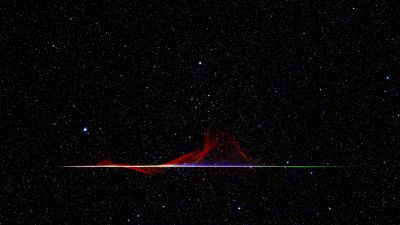
A colourful quadrantid meteor
American photographer Frank Kuszaj wasn't planning to capture a meteor the night he took this photograph, which took him the top prize in the competition's "Planets, Comets and Asteroids" category. He and his friends were planning to photograph nebulae and distant galaxies. But a Quandrantid meteor zoomed by in a green flash, and Kuszaj just happened to be in the right place to capture it in blazing color.
Equipment used: Sony a7R III camera, SkyWatcher Star Adventurer star tracker, 70 mm f/2.8 lens, ISO 3200, 1-minute exposure
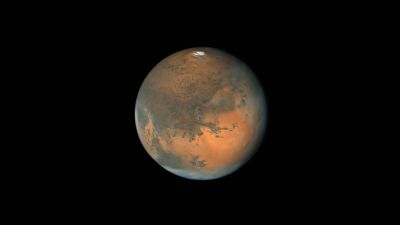
Perseverance
The planet Mars gets all the focus in this runner-up image in the "Planets, Comets and Asteroids" category of the Astronomy Photographer of the Year 13 competition. U.K. photographer Damian Peach named the photograph "Perseverance" both in honor of the Mars Rover of the same name and because it took more than 100 nights of observation to catch the perfect conditions for this photograph.
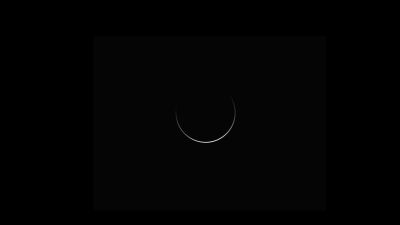
3° from the Sun - The Horn Extensions of Venus
The atmosphere of Venus glows with residual light from the sun in this "highly commended" image in the "Planets, Comets and Asteroids" category.
"This picture of Venus took my breath away. I was drawn to the contrast between darkness and light. The extended crescent resembles our Moon and yet is different, evoking a sense of familiarity and otherworldliness at the same time," said competition judge Imad Ahmed.

Luna Dune
The dunes of Death Valley National Park echo the desolation of the moon in this winning shot in the "Skyscapes" category of the 2021 competition. U.S. photographer Jeffrey Lovelace hiked deep into the park's dunes to capture this shot just after sunset.
Equipment used: Sony ILCE-7RM4 camera; Sand and sky: 70 mm f/8 lens, ISO 400, Sand: 30-second exposure, Sky: 1-second exposure; Moon: 200 mm f/2.8 lens, ISO 100, Moon face: 2.5-second exposure, Moon edge: 1/100-second exposure
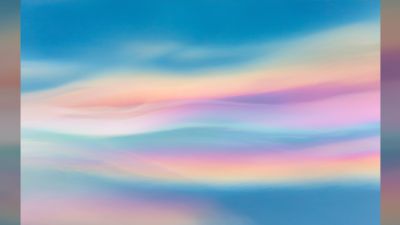
Van Gogh's Sketchpad
An unreal skyscape appeared over Lugu Lake in Yunnan, China in early 2021, and photographer Jin Yang was there to capture the brilliant colors of the clouds, earning a "highly commended" in the "Skyscapes" category.
"This incredible phenomenon lasted for ten days in total and promised good luck for the New Year in Chinese folklore," the photographer said. "If Van Gogh saw this beautiful scenery, he would certainly marvel at the extraordinary craftsmanship of nature saying how fantastic it is."
Equipment used: Canon 6D2 camera, Sigma 546 mm f/8 lens, ISO 100, 1/640-second exposure

California Dreamin'
U.S. photographer Terry Hancock captured this shot of the California Nebula from Whitewater, Colorado, spending seven nights photographing this nebula 1,000 light-years from Earth with narrowband and broadband filters. It took home the top prize in the "Stars and Nebulae" 2021 category.
Equipment used: Takahashi FSQ130 telescope at f/5, Chroma Narrowband filters, Paramount ME mount, QHY600M camera, L-RGB-Ha-SII-OIII composite; 16.1-hours total exposure

Clouds in IC 2944
IC 2944, also known as the Running Chicken Nebula, shines in red and blue in this runner-up image of the "Stars and Nebulae" category of the 2021 astronomy photography competition. Romanian photographer Bogdan Borz captured this image of the nebula — 6,000 light-years away — from Chile.
Equipment used: Astro Systeme Austria 500 mm Newtonian telescope at f/3.8, Astrodon filters, ASA DDM85 Equatorial Mount, FLI Proline PL16803 camera, Ha-SII-OIII composite, 2 hours 42 minutes total exposure
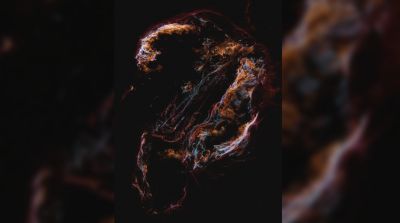
The Colour Splash of Cygnus Loop
"The layers and structures of the Cygnus Loop are so sophisticated," U.S. photographer Min Xie said of the supernova remnant visible in this "highly commended" image in the 2021 "Stars and Nebula" category.
"This is an image that every astronomer and astrophotographer wants to see at least once in their lifetime: the entire, pure Cygnus supernova remnant, cleared from every disturbing element," said László Francsics, competition judge. "As a result, this calm, emblematic bubble structure emerges from the dark, with uncountable details. This astro-image is a unique photograph."
Equipment used: Takahashi FSQ-106EDX III telescope with f/3 0.6x reducer, Chroma filters, Astro-Physics Mach1GTO CP3 mount, ZWO ASI1600MM-Cool camera, Ha-SII-OIII composite, 168 hours total exposure
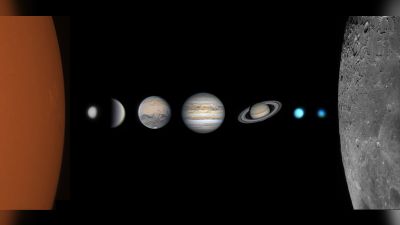
Family Photo of the Solar System
The Young photographers category of the Astronomy Photographer of the Year competition honors photographers under the age of 16. The winning image was taken by a 15-year-old Chinese student who captured shots of every planet in the Solar System besides Earth during the lunar Year of the Rat (2020-2021).
Equipment used: Celestron C8 Schmidt-Cassegrain telescope, UV/IR cut filter, Celestron AVX mount, ZWO ASI-224-MC camera; Sun: 200 mm f/10 lens, Baader filter, 750 x 18-millisecond exposures; Moon: Omni 2x Barlow 200 mm f/10 lens, 2,250 x 10-millisecond exposures; Planets: Omni 2x Barlow 4000 mm f/20 lens; multiple 7–46-millisecond exposures
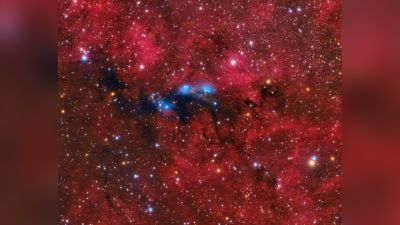
Nebula
Indian teenagers Hassaana Begam and Aathilah Maryam H. took the runners-up place in the youth category for this striking shot of the nebula complex NGC 6914, located about 6,000 light-years away in the constellation Cygnus.
Equipment used: SkyWatcher Equinox ED120 double refractor telescope at f/19, Astrodon filters, NEQ-6 Pro mount, QSI 660 WSG-8 camera, 5.75 hours total exposure
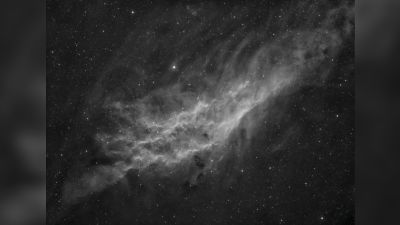
Starry Beach in Space
Three young competitors were awarded "highly commended" in the Youth category of the 2021 astronomy competition. The first, Dutch 13-year-old Davy van der Hoeven, was recognized for this moody view of the California Nebula.
"This image makes me think of a beach where the waves are hitting the coast during a stormy evening," van der Hoeven said. "I made this image with my father's telescope and camera on a winter evening in November."
Equipment used: WO Spacecat51 telescope at f/4.9, SkyWatcher NEQ6 mount, QSI 583WS camera, 26 x 1200-second exposures
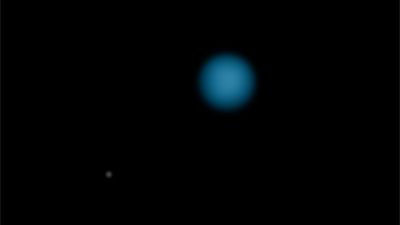
Vanilla v2.85.0 ( View All ) AvatarChristine Lunsford Articles New article Authors Tags Products Redirects Files Curation DefaultFacebookTwitter TITLE Astrophotographers capture stunning views of the night sky (Photos) STRAPLINE e.g. The iphone tops the list again SYNOPSIS Here's a look at stunning astronomy images from the Royal Observatory Greenwich's Astronomy Photographer of the Year competition. LISTING IMAGE clouds-in-ic-2944.jpg Change imageRemove image Romanian photographer Bogdan Borz captured this image of the nebula IC 2944 — 6,000 light-years away — from Chile. Image caption Endorsement Image HERO IMAGE Choose hero image Use listing image as hero Endorsement Image The heavens look gorgeous through the lenses of expert astrophotographers. Nebulas, galaxies, the moon and sun, and even the stars take on an artistic glow when captured with the right eye, equipment and light. Here's a look at stunning astronomy images from the Royal Observatory Greenwich's Astronomy Photographer of the Year competition. (Read more about the competition and its winners.) The Golden Ring Astronomy Photographer of the Year 13 The overall winner of the 13th annual Astronomy Photographer of the Year award is photographer Shuchang Dong of China, who took this unearthly shot of an annular solar eclipse from the Ali region of Tibet on June 21, 2020. The image also won in the "Our Sun" category of the competition. The photograph is "moody, serene, perfectly captured and expertly processed. You feel as if you could reach into the sky and place this onto your finger," said contest judge Steve Marsh. (Equipment used: Fujifilm XT-4 camera; Sun: 386 mm f/10 lens, ISO 160, 1/2000-second exposure; Moving cloud: ND1000 filter, 386 mm f/16 lens, ISO 160, 1-second exposure) The Sun sharing its Crown with a Comet Vincent Bouchama (France) with The Sun sharing its Crown with a Comet (Runner-Up) Runner-up in the "Our Sun" category goes to a stunning image of an eclipse, which shows the tendrils of the sun's upper atmosphere (corona) as well as bright spots seen during eclipses called Bailey's Beads. Most surprising is comet C/2020 X3 (SOHO), swooping in from the far right side of the image. French photographer Vincent Bouchama caught this shot from Argentina. (Equipment used: William Optics ZenithStar 61II APO telescope, Williams Optics Flat 61 lens at f/5.9, Vixen GPD SkySensor 2000PC mount, Canon EOS 760D camera; Sky, sun and comet: ISO 200–800, 1/800–0.6-second exposures; Moon: ISO 200–800, 0.6-second exposures; Prominences and Baily's beads: ISO 200, 1/4000-second exposures) Curtain of Hydrogen Alan Friedman (USA) with Curtain of Hydrogen (Highly Commended) A prominence of hydrogen dances off the sun in this image captured by American Alan Friedman from Buffalo, New York. This image took home a "highly commended" in the "Our Sun" category. "This beautiful large prominence graced the limb of the Sun over several days and was recorded in good seeing conditions," Alan said in a statement. "Good seeing conditions here refer to the steadiness of the Earth's atmosphere rather than to cloudless skies. Only when the atmospheric turbulence is low can fine details and structures be seen with clarity." (Equipment used: Astro-Physics 92 mm f/4.8 Stowaway refractor telescope working at 1.7 m focal length with Baader FFC, 90 mm Coronado Solarmax Ha filter, Astro-Physics 1200 mount, Grasshopper 2MP monochrome streaming camera, 1/1000-second exposure) Polar Lights Dance Dmitrii Rybalka (Russia) with Polar Lights Dance (Winner) The Northern Lights dance over the approach to the Kara Strait in Russia in this image taken in a 25-second exposure by Russian photographer Dmitrii Rybalka that won the Astronomy Photographer of the Year "Aurorae" category. "I was keeping watch at night as Third Officer on the bridge of the ship, when I noticed in the sky a tiny white band approaching like a snake," Rybalka said in a statement. "I knew already, this is it, this is that I was waiting for. I took my camera, went to the bridge wing, took my position and started waiting, like a hunter waiting for its prey. A few minutes later, the sky was full of bright green lights dancing in darkness and shining over everything on their way." (Equipment used: Sony ILCE-7M3 camera, 28 mm f/2.8 lens, ISO 100, 25-second exposure) Proper Welcome for the Moon Thomas Kast (Finland) with Proper Welcome for the Moon (Runner-Up) Finnish photographer Thomas Kast caught the aurora in conjunction with the moonrise in Lapland. This image was the runner-up in the "Aurorae" category of the Astronomy Photographer of the Year competition. "It was a quiet, calm night at this lake watching the moonrise when suddenly the aurora became very strong and started to dance quickly," Kast said. "Further out on the lake there was fog which gave the Moon a nice circle as well. The reflections were magical!" Equipment used: Nikon D850 camera, 15 mm f/2.8 lens, ISO 400, 1.6-second exposure Goðafoss Flow Larryn Rae (New Zealand) with Goðafoss Flow (Highly Commended) The semifrozen Goðafoss waterfall in northern Iceland provides an icy counterpoint to the Northern Lights in this image, which took home a "highly commended" in the "Aurorae" category of this year's photography competition. Photographer Larryn Rae captured this image on a 14-degree Fahrenheit (minus 10 degrees Celsius) night when the full moon and the aurora flooded the landscape with light. Equipment used: Canon EOS 5D Mark IV camera, 24 mm f/2.5 lens, ISO 2500, 16 x 2.5-second exposures The Milky Ring The Milky Ring by Zhong Wu Taking the prize in the competition's "Galaxies" category is Chinese photographer Zhong Wu's "The Milky Ring." This image is a 360-degree image of the Milky Way stitched together with photos taken in China and New Zealand. Equipment used: Nikon D810a camera, 40 mm f/1.4 lens, ISO 8000, 1000 x 6-second exposures The Nebulae of the Triangulum Galaxy The Nebulae of the Triangulum Galaxy by Russell Croman American Russell Croman took runner-up in the "Galaxies" competition with this sparkly spot of the heart of the Triangulum Galaxy, which he took from New Mexico. "In ideal circumstances, it is just possible to see this galaxy with the naked eye despite being more than two and a half million light years away." Russell said in a statement. "Most magnified images concentrate on the vibrancy and clarity of the billions of stars within. Here, we have something rather different, highlighting the delicate nebulosity of the galaxy. The planets forming around the new stars within those stellar nurseries may one day teem with life of their own." Equipment used: Takahashi FSQ106 EDX4 530 mm telescope at f/5 and PlaneWave 14" CDK 2543 mm telescope at f/7.2, Chroma filters, Software Bisque Paramount MX+ and Paramount ME-II mounts, RB-SII-Ha-OIII composite, 49.5 hours total exposure A Smiley in Space A Smiley in Space by Nicolas Rolland and Martin Pugh Recognized as "highly commended" by the Astronomy Photographer of the Year judges, this image seems to smile back at the viewer. An edge-on view of the galaxy NGC 1055 forms a wry smile, while stars in the Milky Way in the foreground seem to twinkle like eyes. The photographers are from France and Australia and captured this image from Chile. Equipment used: Planewave CDK 17" telescope at f/6.8, Astrodon filters, Software Bisque Paramount ME mount, SBIG STXL-11002 camera, L-RGB-Ha composite, 27.5 hours total exposure Beyond the Limb Nicolas Lefaudeux (France) with Beyond the Limb (Winner) This shot that seems to come from an alien galaxy is the winner of the Astronomy Photographer of the Year 13 "Our Moon" category. As the competition name suggests, it is in fact the surface of Earth's moon, with the crescent of Venus rising above its horizon. French photographer Nicolas Lefaudeux captured this image in daylight. Equipment used: Celestron C11 2800 mm telescope at f/10, iOptron iEQ30 mount, Basler ACA2500-14GC camera. Occultation: 1 x 2.5-millisecond exposures. Venus: 50 x 2.5-millisecond exposures. Moon: 200 x 15-millisecond exposures Lunar Halo Göran Strand (Sweden) with Lunar Halo (Runner-Up) Taking the runner-up spot in the "Our Moon" category is Swedish photographer Goran Strand. Strand's image shows the light of the moon reflecting in suspended ice crystals above a snowy landscape in Östersund, Sweden. The tracks belong to a local rabbit. Equipment used: Nikon Z6 II camera, 14 mm f/5.6 lens, ISO 200, 6 x 15-second exposures Iridum to Imbrium Stefan Buda (Australia) with Iridum to Imbrium (Highly Commended) The lunar landscape gets its due in this "highly commended" image in the "Our Moon" category. Australian photographer Stefan Buda increased the color saturation on this image to highlight the desolation of the moon's surface. Equipment used: Self-built Dall-Kirkham 405 mm telescope at f/16, self-built Alt-Azimuth fork mount, Astrodon RGB filters, ZWO ASI120MM camera, 9,000 x 0.0625-second exposures Lockdown Deepal Ratnayaka (UK) with Lockdown (Winner) The pandemic lockdown of early 2020 led to this image captured in Windsor in the United Kingdom. This image took home the winning prize in the "People and Space" category of this year's Astronomy Photographer of the Year competition. Equipment used: Sony ILCE-6600 camera, 8 mm f/4 lens; Foreground: ISO 1600, 8-second exposure; Sky: ISO 1000, 844 x 30-second exposures A Lonely Ship Under the Stars André van der Hoeven (Netherlands) with A Lonely Ship Under the Stars (Runner-Up) The comet NEOWISE streaks across the sky above a ship passing through the Nieuwe Waterweg canal near Rotterdam. Photographer André van der Hoeven captured the blurred lights of the moving ship and the comet's long tail superimposed against a purple-blue sunset. The image won runner-up in the "People and Space" category. Equipment used: Tamron 24–70 mm telescope at f/2.8, Nikon D810a camera, ISO 800, 5-second exposure Break of a New Day Nicholas Roemmelt (Germany) with Break of a New Day (Highly Commended) German photographer Nicholas Roemmelt captured this shot in the snowy mountains of Tyrol, Austria, as astronomical dawn broke over his camping spot. The judges awarded this photograph a "highly commended" recognition in the "People and Space" category. "The beginning of the astronomical dawn usually marks the end of the shooting for the astro landscape photographer as the Milky Way and its wonderful colours are quickly fading. But this short period in between the night and the very beginning of the new day has always been a very special moment for me," Nicholas said. "It is probably the most calm time of the day and somehow 'soothes my soul.'" Equipment used: Canon R(a) camera; Sky: 20 mm f/4 lens, MSM rotator, ISO 6400, 5 x 60-second exposures; Foreground: f/2.8 lens, ISO 2500, multiple 1/10–8-second exposures A colourful quadrantid meteor Frank Kuszaj (USA) with A Colourful Quadrantid Meteor (Winner) American photographer Frank Kuszaj wasn't planning to capture a meteor the night he took this photograph, which took him the top prize in the competition's "Planets, Comets and Asteroids" category. He and his friends were planning to photograph nebulae and distant galaxies. But a Quandrantid meteor zoomed by in a green flash, and Kuszaj just happened to be in the right place to capture it in blazing color. Equipment used: Sony a7R III camera, SkyWatcher Star Adventurer star tracker, 70 mm f/2.8 lens, ISO 3200, 1-minute exposure Perseverance Damian Peach (UK) with Perseverance (Runner-Up) The planet Mars gets all the focus in this runner-up image in the "Planets, Comets and Asteroids" category of the Astronomy Photographer of the Year 13 competition. U.K. photographer Damian Peach named the photograph "Perseverance" both in honor of the Mars Rover of the same name and because it took more than 100 nights of observation to catch the perfect conditions for this photograph. 3° from the Sun - The Horn Extensions of Venus Martin Lewis (UK) with 3° from the Sun – The Horn Extensions of Venus (Highly Commended) The atmosphere of Venus glows with residual light from the sun in this "highly commended" image in the "Planets, Comets and Asteroids" category. "This picture of Venus took my breath away. I was drawn to the contrast between darkness and light. The extended crescent resembles our Moon and yet is different, evoking a sense of familiarity and otherworldliness at the same time," said competition judge Imad Ahmed. Luna Dunes Jeffrey Lovelace (USA) with Luna Dunes (Winner) The dunes of Death Valley National Park echo the desolation of the moon in this winning shot in the "Skyscapes" category of the 2021 competition. U.S. photographer Jeffrey Lovelace hiked deep into the park's dunes to capture this shot just after sunset. Equipment used: Sony ILCE-7RM4 camera; Sand and sky: 70 mm f/8 lens, ISO 400, Sand: 30-second exposure, Sky: 1-second exposure; Moon: 200 mm f/2.8 lens, ISO 100, Moon face: 2.5-second exposure, Moon edge: 1/100-second exposure Moon over Mount Etna South-East Crater Mount Etna erupts in Sicily while the moon floats above it all in this runner-up shot in the "Skyscapes" category. "In February 2021, Etna showed intense volcanic activity spewing ash columns and lava fountains more than 500 metres high. These were mostly located near the new south-east crater which poured numerous lava flows into the Bove Valley," photographer Dario Giannobile said. "They were short in duration but accompanied by intense activity that fractured the structure of the crater from which the flows poured. On 25 February, Mount Etna again showed intense activity and I placed myself at the Piano Bello refuge, calculating the exact position so that the Moon would set near the crater, aligning itself just above." Equipment used: Canon EOS 6D camera, Sigma 150–600 mm lens at 347 mm f/5.6; Foreground: ISO 800, 5-second exposure; Moon: ISO 100, 1/125-second exposure Van Gogh's Sketchpad Jin Yang (China) with Van Gogh's Sketchpad (Highly Commended) An unreal skyscape appeared over Lugu Lake in Yunnan, China in early 2021, and photographer Jin Yang was there to capture the brilliant colors of the clouds, earning a "highly commended" in the "Skyscapes" category. "This incredible phenomenon lasted for ten days in total and promised good luck for the New Year in Chinese folklore," the photographer said. "If Van Gogh saw this beautiful scenery, he would certainly marvel at the extraordinary craftsmanship of nature saying how fantastic it is." Equipment used: Canon 6D2 camera, Sigma 546 mm f/8 lens, ISO 100, 1/640-second exposure California Dreamin' Terry Hancock captured this image of the California Nebula, winning a shortlist spot in the Astrophotographer of the Year contest. U.S. photographer Terry Hancock captured this shot of the California Nebula from Whitewater, Colorado, spending seven nights photographing this nebula 1,000 light-years from Earth with narrowband and broadband filters. It took home the top prize in the "Stars and Nebulae" 2021 category. Equipment used: Takahashi FSQ130 telescope at f/5, Chroma Narrowband filters, Paramount ME mount, QHY600M camera, L-RGB-Ha-SII-OIII composite; 16.1-hours total exposure Clouds in IC 2944 Romanian photographer Bogdan Borz captured this image of the nebula IC 2944 — 6,000 light-years away — from Chile. IC 2944, also known as the Running Chicken Nebula, shines in red and blue in this runner-up image of the "Stars and Nebulae" category of the 2021 astronomy photography competition. Romanian photographer Bogdan Borz captured this image of the nebula — 6,000 light-years away — from Chile. Equipment used: Astro Systeme Austria 500 mm Newtonian telescope at f/3.8, Astrodon filters, ASA DDM85 Equatorial Mount, FLI Proline PL16803 camera, Ha-SII-OIII composite, 2 hours 42 minutes total exposure The Colour Splash of Cygnus Loop Min Xie (USA) with The Colour Splash of Cygnus Loop (Highly Commended) "The layers and structures of the Cygnus Loop are so sophisticated," U.S. photographer Min Xie said of the supernova remnant visible in this "highly commended" image in the 2021 "Stars and Nebula" category. "This is an image that every astronomer and astrophotographer wants to see at least once in their lifetime: the entire, pure Cygnus supernova remnant, cleared from every disturbing element," said László Francsics, competition judge. "As a result, this calm, emblematic bubble structure emerges from the dark, with uncountable details. This astro-image is a unique photograph." Equipment used: Takahashi FSQ-106EDX III telescope with f/3 0.6x reducer, Chroma filters, Astro-Physics Mach1GTO CP3 mount, ZWO ASI1600MM-Cool camera, Ha-SII-OIII composite, 168 hours total exposure Family Photo of the Solar System Family photo of the solar system. The Young photographers category of the Astronomy Photographer of the Year competition honors photographers under the age of 16. The winning image was taken by a 15-year-old Chinese student who captured shots of every planet in the Solar System besides Earth during the lunar Year of the Rat (2020-2021). Equipment used: Celestron C8 Schmidt-Cassegrain telescope, UV/IR cut filter, Celestron AVX mount, ZWO ASI-224-MC camera; Sun: 200 mm f/10 lens, Baader filter, 750 x 18-millisecond exposures; Moon: Omni 2x Barlow 200 mm f/10 lens, 2,250 x 10-millisecond exposures; Planets: Omni 2x Barlow 4000 mm f/20 lens; multiple 7–46-millisecond exposures Nebula Indian teenagers Hassaana Begam and Aathilah Maryam H. took the runners-up place in the youth category for this striking shot of the nebula complex NGC 6914, located about 6,000 light-years away in the constellation Cygnus. Indian teenagers Hassaana Begam and Aathilah Maryam H. took the runners-up place in the youth category for this striking shot of the nebula complex NGC 6914, located about 6,000 light-years away in the constellation Cygnus. Equipment used: SkyWatcher Equinox ED120 double refractor telescope at f/19, Astrodon filters, NEQ-6 Pro mount, QSI 660 WSG-8 camera, 5.75 hours total exposure Starry Beach in Space Dutch 13-year-old Davy van der Hoeven, was recognized for this moody view of the California Nebula, called Starry Beach in Space. Three young competitors were awarded "highly commended" in the Youth category of the 2021 astronomy competition. The first, Dutch 13-year-old Davy van der Hoeven, was recognized for this moody view of the California Nebula. "This image makes me think of a beach where the waves are hitting the coast during a stormy evening," van der Hoeven said. "I made this image with my father's telescope and camera on a winter evening in November." Equipment used: WO Spacecat51 telescope at f/4.9, SkyWatcher NEQ6 mount, QSI 583WS camera, 26 x 1200-second exposures Neptune and Triton Julian Shapiro, 13, of Chapel Hill, North Carolina, was highly commended for this image in the Young photographer category. Shapiro used his telescope to locate and photograph Neptune and its largest moon, Triton. Page 1 Out of 1 CANCEL CLONE PREVIEW VIEW LIVE PUBLISHED ▲ SAVE LibraryUpload Search Type image Name Search with Alt Text Search by tags Highly Commended_Neptune and Triton © Julian Shapiro copy.jpg Highly Commended_Neptune and Triton © Julian Shapiro copy.jpg 720\00d7405jpegEDIT INFO orca-grandma-missing-02.jpg orca-grandma-missing-02.jpg 1737\00d7978jpegEDIT INFO orca-grandma-missing-01.jpg orca-grandma-missing-01.jpg 959\00d7539jpegEDIT INFO fossil-footprints-bennett-3.jpg fossil-footprints-bennett-3.jpg 2800\00d71575jpegEDIT INFO fossil-footprints-bennett-2.jpg fossil-footprints-bennett-2.jpg 800\00d7450jpegEDIT INFO fossil-footprints-bennett-1.jpg fossil-footprints-bennett-1.jpg 2800\00d71575jpegEDIT INFO LaskerAward_9-23-21 (1).jpg LaskerAward_9-23-21 (1).jpg 1024\00d7576jpegEDIT INFO LaskerAward_9-23-21.jpg LaskerAward_9-23-21.jpg 1024\00d7576jpegEDIT INFO recumbent-vs-upright-bikes-getty3.jpg recumbent-vs-upright-bikes-getty3.jpg 1280\00d7720jpegEDIT INFO recumbent-vs-upright-bikes-getty1.jpg recumbent-vs-upright-bikes-getty1.jpg 1280\00d7720jpegEDIT INFO recumbent-vs-upright-bikes-getty2.jpg recumbent-vs-upright-bikes-getty2.jpg 1280\00d7720jpegEDIT INFO GettyImages-1178376528.jpg GettyImages-1178376528.jpg 1920\00d71080jpegEDIT INFO Pregnant-woman---Getty.jpg Pregnant-woman---Getty.jpg 1920\00d71080jpegEDIT INFO Pregnancy---Getty.jpg Pregnancy---Getty.jpg 1920\00d71080jpegEDIT INFO shutterstock_1670309263 2.jpg shutterstock_1670309263 2.jpg 1920\00d71080jpegEDIT INFO shutterstock_1157175928 2.jpg shutterstock_1157175928 2.jpg 1920\00d71080jpegEDIT INFO shutterstock_696880552 2.jpg shutterstock_696880552 2.jpg 1920\00d71080jpegEDIT INFO still_from_Per_Tau_animation_nocaption.jpeg still_from_Per_Tau_animation_nocaption.jpeg 1811\00d71002jpegEDIT INFO Milkyway_zoom_in_0.jpeg Milkyway_zoom_in_0.jpeg 2398\00d71604jpegEDIT INFO california-dreamin.jpg california-dreamin.jpg 955\00d7537jpegEDIT INFO clouds-in-ic-2944.jpg clouds-in-ic-2944.jpg 2800\00d71575jpegEDIT INFO LOAD MORE DESELECT ALL (0) SELECT ALL COPY TO INSERT CANCEL
Julian Shapiro, 13, of Chapel Hill, North Carolina, was highly commended for this image in the Young photographer category. Shapiro used his telescope to locate and photograph Neptune and its largest moon, Triton.
Equipment used: Celestron NexStar 8SE telescope at f/10, Celestron AVX mount, ZWO ASI-224MC camera, 120 x 1-second exposures
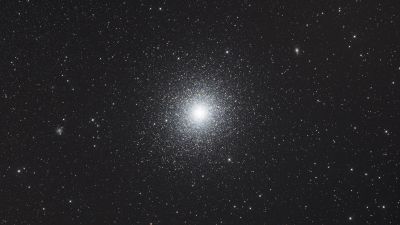
Satellite Cluster around 47 Tucan
The youngest recognized photographer in the 2021 competition is Alice Fock Hang, who captured this image of the globular cluster 47 Tucanae from Les Makes on the Island of Reunion.
"47 Tucan is one of the jewels of the southern sky and is located just above the Small Magellanic Cloud in the balmy summer nights of the southern hemisphere," Hang said. "It is a colourful cluster with a shining heart – a pearl in the Universe."
Equipment used: Takahashi Epsilon 210 telescope at f/2.9, Astro-Physics mount, Nikon D610 camera, ISO 800, 90 x 2-minute exposures

Falcon 9 soars past the Moon
Photographer Paul Eckhardt took the 2021 Manju Mehrotra Family Trust Prize for Best Newcomer for this strikingly composed image of the Falcon 9 rocket zipping in front of the moon. This prize is awarded to astrophotographers with less than two years’ experience who are entering the astrophotography competition for the first time.
Equipment used: Sony ILCE-6500 camera, 210 mm f/8 lens, ISO 400, 1/350-second exposure

Celestial fracture
This artistic composition won the Annie Maunder Prize for Image Innovation, given to artists who create the best images from publicly available data. U.K. photographer Leonardo Di Maggio created this piece with photographs taken of Saturn by the Cassini mission.
"The patterns formed by Saturn, its rings and its moons are truly magnificent," Di Maggio said. "The photographs have echoes of architecture, nature, art and design, and are just as artistically inspirational as they are crucial for scientific study."

A cloudy day on Jupiter
Sharing the Annie Maunder Prize for Image Innovation this year is Sergio Diaz Ruiz, a Spanish photographer who created this colorful image of Jupiter's clouds from Hubble Telescope data. "High clouds on Jupiter create intricate and beautiful shapes that swirl all over the planet," Ruiz said.
Originally published on Live Science.

Stephanie Pappas is a contributing writer for Space.com sister site Live Science, covering topics ranging from geoscience to archaeology to the human brain and behavior. She was previously a senior writer for Live Science but is now a freelancer based in Denver, Colorado, and regularly contributes to Scientific American and The Monitor, the monthly magazine of the American Psychological Association. Stephanie received a bachelor's degree in psychology from the University of South Carolina and a graduate certificate in science communication from the University of California, Santa Cruz.

